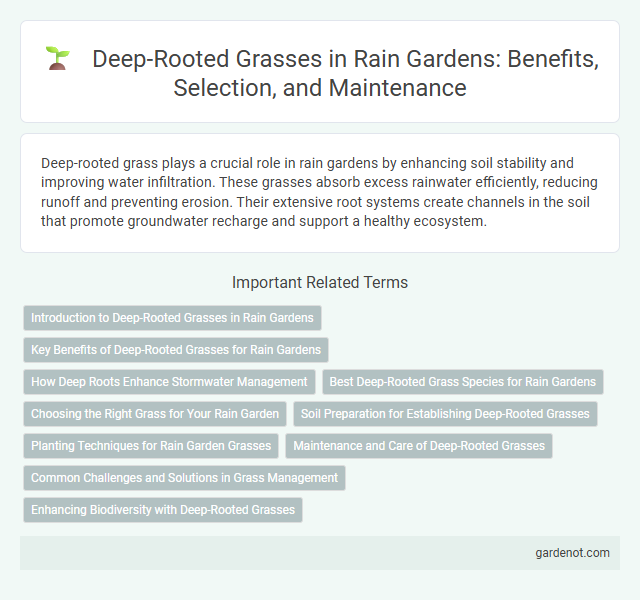Deep-rooted grass plays a crucial role in rain gardens by enhancing soil stability and improving water infiltration. These grasses absorb excess rainwater efficiently, reducing runoff and preventing erosion. Their extensive root systems create channels in the soil that promote groundwater recharge and support a healthy ecosystem.
Introduction to Deep-Rooted Grasses in Rain Gardens
Deep-rooted grasses in rain gardens enhance soil infiltration and improve water retention by developing extensive root systems that reach deep into the soil profile. These grasses, such as switchgrass (Panicum virgatum) and little bluestem (Schizachyrium scoparium), stabilize the soil and reduce erosion while promoting nutrient uptake and pollutant filtration. Integrating deep-rooted grasses in rain gardens supports sustainable stormwater management by increasing groundwater recharge and mitigating runoff volume.
Key Benefits of Deep-Rooted Grasses for Rain Gardens
Deep-rooted grasses in rain gardens enhance stormwater infiltration by creating extensive root networks that improve soil structure and increase water absorption. These grasses stabilize soil, reduce erosion, and filter pollutants, promoting healthier ecosystems and cleaner runoff. Their drought tolerance and adaptability make them ideal for sustaining rain garden function during varying weather conditions.
How Deep Roots Enhance Stormwater Management
Deep-rooted grasses improve stormwater management by increasing soil infiltration rates and reducing surface runoff. Their extensive root systems stabilize soil, prevent erosion, and create channels that allow water to percolate into deeper soil layers. This enhanced infiltration reduces the risk of flooding and filters pollutants before groundwater recharge.
Best Deep-Rooted Grass Species for Rain Gardens
Big Bluestem (Andropogon gerardii) stands out as one of the best deep-rooted grass species for rain gardens due to its ability to reach root depths of up to 8 feet, which enhances soil infiltration and erosion control. Switchgrass (Panicum virgatum) is another excellent choice, known for its drought tolerance and extensive root system that improves water retention and supports wetland habitats. Little Bluestem (Schizachyrium scoparium) offers adaptability to various soil types while promoting biodiversity and stabilizing soil in rain garden environments.
Choosing the Right Grass for Your Rain Garden
Selecting deep-rooted grass for your rain garden enhances soil stabilization and improves water infiltration, reducing runoff effectively. Opt for native species like switchgrass (Panicum virgatum) or big bluestem (Andropogon gerardii), which are adapted to local climates and support rain garden ecosystems. These grasses develop extensive root systems that promote groundwater recharge and increase resilience to variable moisture conditions.
Soil Preparation for Establishing Deep-Rooted Grasses
Soil preparation for establishing deep-rooted grasses in rain gardens involves thorough loosening and aeration to promote root penetration and water infiltration. Incorporating organic matter such as compost enhances soil structure, nutrient availability, and moisture retention critical for deep root development. Proper pH adjustment and avoiding soil compaction optimize conditions for robust, drought-resistant grass growth essential in rain garden ecosystems.
Planting Techniques for Rain Garden Grasses
Deep-rooted grasses, such as switchgrass and little bluestem, enhance rain garden performance by improving soil infiltration and stabilization. Planting techniques emphasize spacing roots deeply to maximize water absorption and prevent erosion, with a recommended depth of 12-18 inches for optimal root establishment. Ensuring well-prepared soil with organic matter and avoiding compaction supports vigorous root development crucial for sustained rainwater management.
Maintenance and Care of Deep-Rooted Grasses
Deep-rooted grasses in rain gardens require minimal maintenance due to their natural drought tolerance and soil stabilization properties. Regular inspection for invasive species and occasional pruning during early spring support healthy growth and optimize water infiltration. Ensuring proper mulching around the base helps retain moisture and suppress weeds, promoting the longevity and effectiveness of these grasses in stormwater management.
Common Challenges and Solutions in Grass Management
Deep-rooted grasses in rain gardens often face challenges such as root compaction and waterlogging, which can inhibit growth and reduce filtration efficiency. Implementing periodic aeration and selecting species tolerant to varying moisture levels enhance root health and soil permeability. Incorporating organic mulches and maintaining proper drainage prevent water stagnation, promoting a resilient grass root system.
Enhancing Biodiversity with Deep-Rooted Grasses
Deep-rooted grasses in rain gardens improve soil structure and water infiltration, creating a habitat that supports diverse microorganisms and pollinators. These grasses stabilize the soil by preventing erosion, fostering a thriving ecosystem for native plants and beneficial insects. Their extensive root systems also enhance nutrient cycling, contributing to overall biodiversity and ecosystem resilience.
Deep-rooted grass Infographic

 gardenot.com
gardenot.com